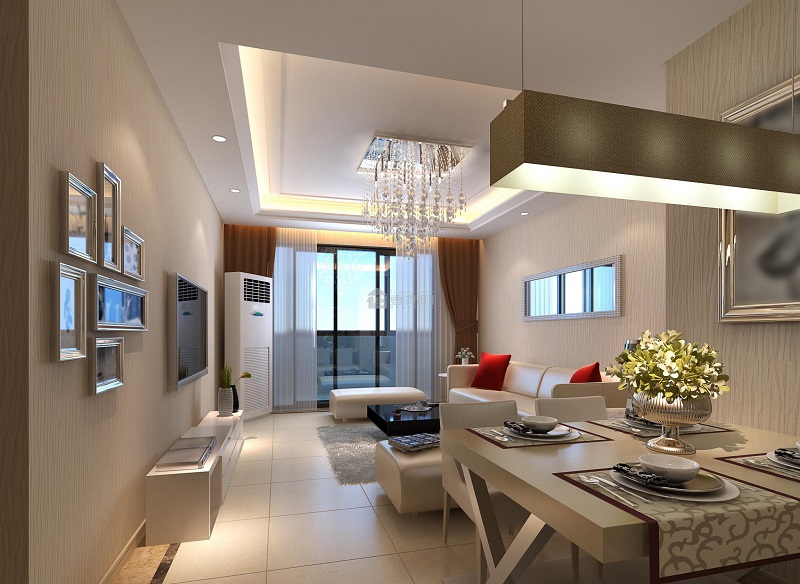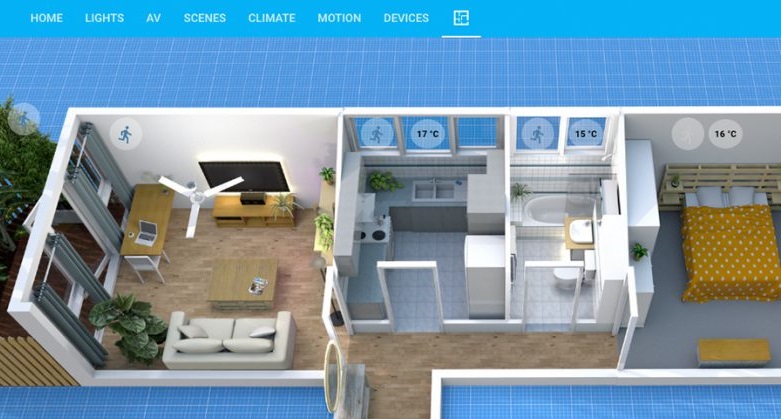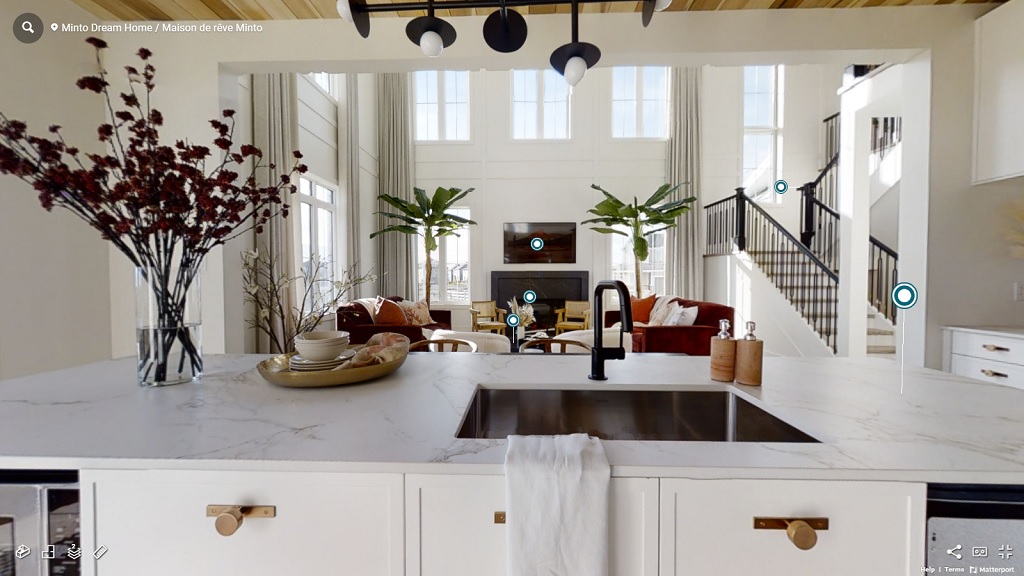You will soon begin noticing increasing references to Digital Twins, as they pertain to homeownership – especially in terms of design, home automation and energy efficiency. In this article, we share key concepts and examples of Digital Twin Technology that are of most importance and relevance to Homeowners.
Table of Contents
- What is a Digital Twin of a Home?
- Example of a Residential Digital Twin
- Types of Digital Twins for a Home
- The Benefits of Digital Twins for Homeowners
- How is a Digital Twin Created?
- Digital Twin Case Study for the Home Industry
- Technologies Related to Digital Twins
- Recommended Reading
What is a Digital Twin of a Home?
In the context of residential real estate, a Digital Twin refers to software with digital assets that virtually replicates a corresponding house or its subsections. In other words, you can create a twin of your home with all of its systems, appliances and household items in digital form, to help you better understand, manage and make better use of all aspects of your property.
Example of a Residential Digital Twin
Embedded below is an easy-to-understand demonstration of a Digital Twin of a 1-bedroom home in Melbourne, Australia, created by James Litjens, a technology director with Arq Group. The video shows the value and process of a Digital Twin for the home using current technology. An ingenious feature that Litjens implemented with his Digital Twin was to prevent interruptions during virtual conference calls, by turning on a specific light that indicated “Busy – Live Call”.
I Built a Digital Twin of My Home in Lockdown – Emerging Technology
Types of Digital Twins for a Home
Over time, Digital Twins for the Home will continually facilitate “easier-to-use-and-understand” software, while delivering increasing levels of functionality, which will empower homeowners to manage, use, maintain and enjoy their homes more effectively. Key to the evolution of Digital Twins for the home, will be the seamless integration of disparate smart devices and systems.
Residential Digital Twins can be classified into four general groups, representing advancing levels of capabilities:
- Basic 3D Visual Renderings
- Interactive 3D Renderings with Static Data
- Interactive 3D Renderings with Dynamic Data
- Interactive 3D Renderings with Intelligent & Automated Use of Dynamic Data
1. Basic 3D Visual Renderings
A residential Digital Twin could be as simple as a 3D-rendered space of your entire home or individual rooms, consisting of: building structure; floorplans; windows; appliances; furniture; flooring; artwork; decor and more. A homeowner’s first foray into experiencing a Digital Twin is often unknowingly, when first seeing a 3D rendering of a proposed remodeling of a specific room, created by a professional designer or builder.
Photographic 3D renderings of your home and belongings are an even better first step into creating a Digital Twin, as they serve as more accurate archives for insurance purposes.

2. Interactive 3D Renderings with Static Data
The next level of a Digital Twin incorporates extensive data on your home and its many contents. Examples of static data of your household belongings would include: serial numbers, model numbers, product warranty information, purchase dates, supplier information, and cost-of-replacement values. This type of static data capture of your home would be even more valuable for insurance purposes, if any items were to be damaged or lost.
Examples of static data of your home’s structure would include: accurate 3D dimensions of rooms and layouts, material types of flooring, cabinetry, counters, fixtures, etc. This information would be vital for circumstances that required rebuilding sections or, in some cases, complete homes.
3. Interactive 3D Renderings with Dynamic Data
Digital Twins for residential properties will become more sophisticated and powerful, especially as homes adopt more interconnected smart products and systems. Digital Twins that include interactive devices, such as smart thermostats and lighting, can be used as a holistic dashboard to control all of the many systems and devices within your home.
With this type of twin, homeowners are not only able to interact with the physical home through a virtual interface, but they are also able to collect invaluable data, as a means to help better understand, manage and maintain their homes. Automated counting of appliance usage cycles with notifications of required maintenance tasks are one example of how Digital Twins can help prolong the lifespan of household appliances and alert you to required preventative maintenance.
Dynamic data external to one’s home can also be collected and correlated, such as weather data tied to HVAC usage, via a smart thermostat.

4. Interactive 3D Renderings with Intelligent & Automated Use of Dynamic Data
The most advanced Digital Twins for the Home incorporate artificial intelligence and advanced sensors to increase seamless automation, improved energy performance, and personalized comfort for occupants. Much that is being learned in truly smart commercial buildings will eventually propagate to smaller-scaled solutions for residential applications.
The ability for a Digital Twin to gather real-time data continuously (from appliances and systems, for example), then to analyze the data, and then to take proactive actions, comes under the tech umbrellas of Automated Home Performance and Prescriptive Maintenance.
Prescriptive Maintenance not only predicts issues, but it prescribes solutions (such as automated software updates or adjustments to settings).
Sensors, in tandem with artificial intelligence and machine learning, are what will bring about the fruition of self-learning homes.
This video overview of LG’s ThinQ Smart Home Solution gives a good overview of the potential for truly smart homes driven by intelligent Digital Twin technology.
The Benefits of Digital Twins for Homeowners
Digital Twins represent many benefits and opportunities for homeowners. As the capabilities of residential Digital Twins increase, so do the corresponding benefits. To reiterate, the immediate benefit to homeowners will be achieved after first capturing the 3D floorplans of your house, and the contents within, for insurance purposes. Additional benefits that are achievable for more robust digital twins, include:
- Accurate Asset Management for Insurance Purposes
- Detailed 3D Construction Floorplans for Insurance Purposes
- Increased Energy Efficiency & Home Performance
- Improved Comfort & Wellness
- Prolonged Appliance & System Lifespans
- Interactive 3D Tours for Resale Marketing
- Performance Data for Resale Marketing
- Maintenance Data & Records for Resale Marketing
- Virtual Caregiving for Remote Loved Ones
- Self-Learning Homes for Optimal Usage
- Digital Assets for Resale (e.g. Digital Twin of a Remodeled Room)
How is a Digital Twin Created?
To create the beginnings of a basic Digital Twin (e.g. an interactive 3D photographic rendering), we recommend that you sign up for a free account with Matterport, the leading 3D media platform that makes it easy to create interactive 3D photographic tours of real-world places.
A free Matterport account will allow you to:
- Capture unlimited 3D spaces with iOS and Android devices and 360 cameras
- Edit and add markup features for one active space at a time
- Share iOS and Android-captured 3D spaces for one active space at a time
- Have unlimited archive retrieval
Also see:
- How to Capture a Digital Twin
- Matterport Homeowner Tips
- Matterport 3D Mobile Camera App for iOS and Android Devices
- Matterport Axis™ Motorized Mount
- Matterport 3D Tour Gallery
- Professional Matterport 3D Capture Services
Digital Twin Case Study for the Home Industry
Roombus: A Next Generation Smart House
Roombus is a manufacturer of eco-friendly, affordable, factory-built, next-generation modular Smart Houses. Though Roombus does not state that their homes come with a Digital Twin, in our opinion, their Roombus app meets the spirit of the definition.
Their newest model, Nest, features embedded sensors that intelligently monitor indoor air quality, filtering out dust, viruses, and other pollutants hundreds of times daily. Their homes can be controlled and operated by the Roombus app in-person or remotely.
Also see:
- Prescriptive Maintenance
- Integrated 360 Degree Virtual Tours
- Virtual Staging 360 Degree Tours
- Shoppable 3D Experiences
Technologies Related to Digital Twins
- Virtual 3D Models (AKA 3D Design Renders)
- Modeling & Simulation of Processes
- Asset Management
- Performance Analysis
- Prescriptive Maintenance
- Product Data Feeds
- BIM: Building Information Modeling
- iOT: Internet of Things (AKA smart devices)
- Augmented Reality
- Virtual Reality
- Data Capturing & Management
Recommended Reading
- Why Prescriptive Maintenance is the Cure for Homeowner Headaches
- How Technology is Influencing What Consumers Want from Homeownership
- Need Renovation Inspiration? Try These Innovative Design Resources!
- The Many Benefits of Virtual Staging: Selling, Renovating & Decorating
- The New American Home 2022: A Courtyard Design for a Narrow Lot
- The New American Remodel 2022: A Mid-Century “Modernized” Preservation
- The New American Remodel 2021: Sustainable & Energy Efficient Beauty
- How to Choose a Water Leak Detection System for Your Home
- Improve Your Landscaping with a Smart Irrigation System
| Purgula is reader-supported. When you click on links to other sites from our website, we may earn affiliate commissions, at no cost to you. If you find our content to be helpful, this is an easy way for you to support our mission. Thanks! Learn more. |







